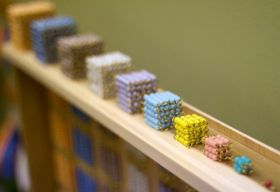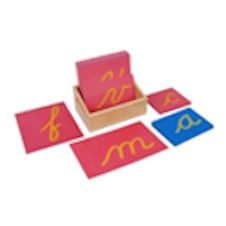Montessori Lesson
from an interview with Montessori teacher Lila Carusillo who taught for thirty years at Aquinas Montessori School before retairing in 2006
If someone asked me to define Montessori it would be … total respect for the
child as a unique individual. Children have this inner urge to become adults. From the time they're born they're imitating adults. We have to trust the child.
Montessori education stresses that children teach themselves to be adults by interacting with their environment, not by the lessons that adults try to impose on
them.
We didn't teach the child the language, the child learned it from the environment, so keep the child's environment cultural, beautiful, and clean, and do not fill
their heads with fantasy from fiction books and movies. We want young children to learn the facts. We don't want a lot of fantasy … Otherwise they can't distinguish between
fact and fantasy … They need to know the language and they need to help in the home and share in the home … We teach the child to know how to take care of themselves by tying
shoes, wiping nose, wiping table. The Aquinas uses real glass, not plastic because the school wants children to know that when they grow up, things will break, and
carelessness has consequences. If everything was plastic and bounced, we wouldn't be teaching them the reality of life.
In keeping with this focus on personal responsibility for learning, the school does not have traditional class periods. The students don't have forty minutes of
math, forty minutes of language, that sort of thing. Children are allowed to work on whatever project interests them, as long as they are working on something. Students also
stay with one teacher for three years. Older children are encouraged to help their younger classmates.

Montessori is hands-on, the axiom that attracts me most to it is, 'Never give more to the eye than the hand can hold.'
The message of simplicity is exemplified by the Montessori materials that should be the only adornments to every classroom. The 'pink tower' is Montessori icon. It is a stack of ten cubes, ascending in size from one centimeter to 10 centimeters. Children stack them. Non-Montessori imitations of the pink tower are less effective. Manufacturers make cubes of other colors. But Maria Montessori made it very simply because what she was teaching the child was dimensions … The purpose of the pink tower is to sensorially introduce the child to dimensions … She isolated what was taught.
Some of the most important Montessori principles to apply at home are … Do not do for the child what the child can do for himself … Decry overindulgence and inactivity and let them know the names of everything in the environment rather than sitting in front of a TV.
